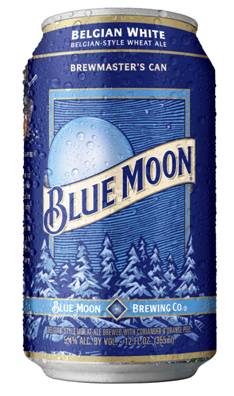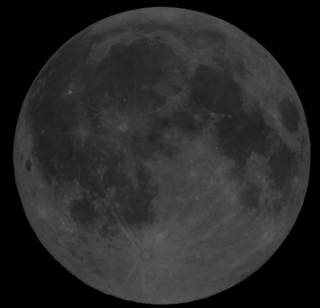This year and next year, the month of August will bring you the two different definitions of the term blue moon. As you know, every 2.7 years the twelve months of the calendar feature thirteen full moons. There are only twelve full moon names, though, so when a “year” has thirteen moons, you have to decide how to name that “extra” moon. (I’ll explain why I put the word year in quotes later.)
As a culture, we’ve collectively decided that such extra moons shall be called blue:
Whoops! Wrong kind. Here’s the kind I’m actually talking about:
That full moon is the most recent blue moon we’ve had, and it occurred on November 20, 2010.
Now, when a calendar year has thirteen full moons. one month must obviously contain two full moons. So, according to the most obvious definition, the second full moon in a month that features two is going to be blue.
However, astute reader that you are, you probably noticed that the date of the last blue moon was November 20. How can we fit two full moons, which by definition are ~29.5+ days apart, into one calendar month?
Well, that’s why I put the word year in quotes in the first paragraph. Because in fact, a calendar year is just an arbitrary means of marking time; another method of doing so uses the seasons. And the seasons, rather than starting on January 1 like our calendar, start instead on astronomical events known as solstices (in December and June) and equinoxes (in March and September). And the dates of those events vary slightly, because our calendar isn’t perfectly in tune with the seasons.
And when you go by the seasons instead of the calendar, months with two full moons in them don’t necessarily have a blue moon (in fact, they can’t).
And in point of fact, this month, August 2012, which has two full moons, has a blue moon if you go by the calendar-year definition, but not if you go by the seasonal definition. The second full moon this month which, barring unforeseen catastrophes, will occur on August 31 at 9:58 a.m. EDT, is a blue moon in the first sense, but not in the second.
What is that seasonal definition of blue moon? I’m glad you asked.
According to the Maine Farmer’s Almanac, which I learned of via this Sky & Tel article, the third full moon in a season that has four is the real blue moon. And next year, again in August (on August 20 at 10:45 p.m. EDT), we will experience a blue moon, this time according to that older, seasonal definition: the third full moon in a calendar season that has four.
While this definition has some fine tradition behind it, it is quite a bit more complicated in practice. After all, according to this definition, it isn’t obvious from the calendar when there will be a blue moon. If you or I look at a calendar year and see 13 full moons, we can have reasonable certainty that one them is “extra.” But according to this traditional definition, that won’t happen in 2012, despite the fact that there are clearly thirteen full moons this year. And in 2013, which has only 12 full moons, there will indeed be a blue moon.
Look at the table below, listing the dates of full moon in 2012 and 2013.
| Full Moons 2012-2013 | ||
|---|---|---|
| 2012 | 2013 | |
| January | 9 | 27 |
| February | 7 | 25 |
| March | 8 | 27 |
| April | 6 | 25 |
| May | 6 | 25 |
| June | 4 | 23 |
| July | 3 | 22 |
| August | 1, 31 | 21 |
| September | 30 | 19 |
| October | 29 | 18 |
| November | 28 | 17 |
| December | 28 | 17 |
The pattern of dates in 2013 shows what’s going on: the June full moon comes only two days after the June solstice (June 21 in 2013). That means that the second full moon of summer will fall in July, the third in August, and the fourth will come only three days before the September equinox. Thus, the third full moon of the season will fall in August, and that month’s only full moon will be blue.
Unfortunately, due to inattentiveness on my part, I missed the first full moon this month. But Matt Wedel, out in sunny CA, did a great job capturing it, and wrote a very nice post about it, which I link to here. He’s doing what I’d always tried to do: explaining and comparing moons, only he’s doing it well, and I’m, well, doing it.
For more on the history of the term blue moon, try this new Sky & Tel article that appeared this week, right as I was putting the finishing touches on this pot.



